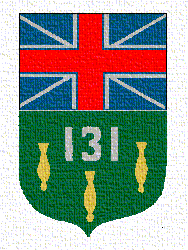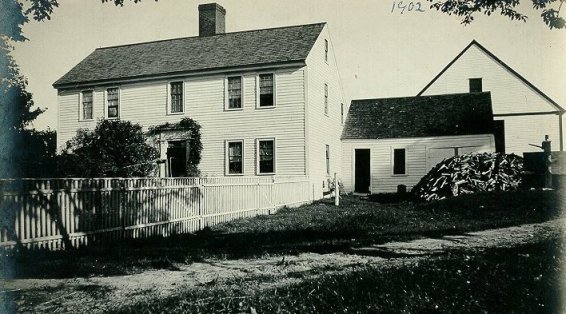
|

|

|

|
Colonel John Robinson
Biography Entry in Massachusetts Soldiers and Sailors


Col. Robinson's house on Robinson Rd. as it appeared
in 1902. Unfortunately, the house was razed by fire in 1937.
A stone marker remains near the original location of
the house.
This image has been reproduced with the kind permission
of Marilyn Day
Each Massachusetts town
has its Revolutionary War heroes. Some served from the first day
of the conflict, while others, due to either distance or age would
serve later. A relative few can be found in the many history
books that have been written since, and in most cases the same small
group is found throughout the narrative of those early days of our
nation. It is the responsibility of each community, to remember
and keep their stories from being forgotten.
One
individual who is well documented to have played a significant role
during the war, and yet has eluded most accounts, is Col. John Robinson
(1735-1805). In late 1774 he was appointed Lt. Col. in the
Northern Middlesex regiment of minutemen commanded by Col. William
Prescott of Pepperell. Being of significant rank, he was one of
the first in Westford to be alerted by an alarm rider of the march of
the Regulars to Concord on the 19th of April, 1775. He and a handful of
other Westford men arrived early at the North Bridge. Major
Buttrick offered command of the march toward the Bridge to Robinson,
his superior officer. He declined, citing that most of his
Northern Middlesex men had not yet arrived, but instead volunteered to
serve at his side at the head of the column. It is said that the
shot which injured Acton's Luther Blanchard passed under Robinson's arm.
Though
we rarely hear of Robinson's involvement that morning it was obvious at
the time. A quick inspection of the only contemporary visual
account of the action at the North Bridge, the famous Ralph Earl print,
confirms this. Based on interviews by Connecticut militiaman Amos
Doolittle within a month of the event, the print’s caption reads, "The Provincials headed by Colonel Robinson & Major Buttrick at the Bridge."
Following
the events at Concord, he continued to serve in the siege army around
Boston. Continuing in Prescott’s regiment, he served as second in
command at the Battle of Bunker Hill, one of the bloodiest engagements
of the Revolutionary War. In a letter
to John Adams written two months after the battle, Prescott wrote of
Robinson that he “behaved with prudence and Courage” as he led a
detachment to flank the enemy. In early 1776 Robinson was
appointed colonel of a regiment of over 400
men in Cambridge in support of the Continental Army under Gen. George
Washington. And later in 1777, Robinson commanded another militia
regiment, keeping watch over British occupied Newport, Rhode
Island.
An unintended consequence
of the war during the summer of 1775 was the spread of diseases from
the Army’s camps around Boston and a significant increase in civilian
deaths in Westford and other surrounding towns. Among these were
three of John and Huldah Robinson’s young daughters, lost within two
weeks.
Robinson distinguished himself throughout his
life. In 1760 he served for over eight months as an officer
during the French and Indian War. His service to the town of
Westford included several years as selectman (1771-73), and as a member
of many town committees.
Following the war, in what became known as Shays’s Rebellion (1786-87), economic injustices drove many to protest by shutting down government institutions such as the courts. Robinson supported one of his former captains, Groton’s Job Shattuck, in the closing of the courts in Concord in September of 1786.
Years later, in 1824, the Rev. Joseph Thaxter,
one of the first army chaplains of the war and a witness of the events
at the North Bridge, said of Robinson, “a braver and more upright man I
never knew.” Further, he proclaimed that “Such men … ought not to
be forgotten by those who write the history of the commencement and
prosecution of our glorious revolution.
Robinson's Regiment -- Camp at Cambridge, 1776
New information has come
to light regarding a militia regiment that was commanded by Col. Robinson
during the siege of Boston. The existence of this regiment is not noted
in past biographies describing Robinson's military career, and so is not
widely known. In February, 2003, it was confirmed that a previously
unrecognized orderly book belonging to "Robinson's Regiment, Camp at Cambridge"
was that of Col. John Robinson. This discovery provided the initial
direction for this new research.
The regiment was one of thirteen New England regiments organized for service in February and March of 1776, and Robinson was chosen as its colonel. George Wahington, then in command of the army laying siege to Boston, was encouraged to request the formation of these militia regiments when it became clear that the new Continental Army enlistments which were to begin on January 1st, 1776 were not as robust as hoped. The commission papers of Westford's Silas Procter, who served as 1st Lieutenant in Josiah Warren's (3rd) company in this regiment, state that his company was "raised by this Colony as a temporary reinforcement to the American Army until the first day of April next...". (As it turned out, the siege ended on March 23rd when the British evacuated Boston as a reaction to the newly entrenched artillery pieces on Dorchester Heights.)
The orderly book has been transcribed and can be found
within the following pages:
The orderly book of Col. John Robinson's Regiment, Camp at Cambridge, Feb - March, 1776
John Buttrick of Concord, who led the provincials at the North Bridge with Isaac Davis and John Robinson, was Robinson's Lt. Col. in this regiment. Rev. Joseph Thaxter served as the regimental chaplain. Westford doctor Asaph Fletcher was commissioned the regimental surgeon. Another notable figure who served in this regiment was Captain Job Shattuck of Groton who would later gain fame as a leader during Shays's Rebellion of 1786-87.
Robinson's Regiment -- Rhode Island, 1777
In 1777 Robinson formed his own regiment for service in Rhode Island. The regiment served there for 6 months until January 1, 1778. Muster rolls for several of the companies of this regiment can be found in the records of the National Archives. Further details will hopefully find their way to this site.
~
The Unintended Consequences of War
In addition to the upheaval caused by the start of the war, personal tragedy struck the Robinson family during the summer of 1775: Within one two week period, three of the children died. On August 30th Sarah died at the age 3 yrs, 3 months, and Betty at the age of 5 yrs, 3 months. Mehitable died on September 9th at the age of 8 yrs, 28 days. Although the cause is not certain, it is quite likely that they were victims of the diseases that were being brought out into the countryside from the military camps surrounding Boston during the siege of '75-'76. Not uncommon during this period, such examples help to remind us that the human costs of the war were not limited to soldiers in battle, but by indirect means to their families at home as well.
~
The following short biography is taken from Hodgman's History of Westford:
He was the son of Jacob and Mary (Gould) Robinson, and was born in Topsfield, 1735, and died in Westford, June 13, 1805. He married Huldah Perley, of Boxford, November 27, 1764. Their children were:
1. Huldah, born September 23, 1765.
2. Mehitable, born August 9, 1767.
3. Betty, born May 3, 1770.
4. Sally, born May 3, 1772.
5. Rebecca, born July 7, 1774.
6. John, born February 17, 1781.Col. Robinson was buried in the West Cemetery, and the headstone at his grave bears the following inscription :
"Here reposes the body of Col. John Robinson, who expired June 13th, 1805, aged 70 years. In 1775 he distinguished himself by commanding the corps of soldiers who first opposed the menacing attempts of the British troops at Concord Bridge.
Here rest thine ashes; on thy silent grave May dews distil and laurels gently wave;
Let heralds far proclaim thy soul was fired By love of freedom and by Heaven inspired. First in the glorious cause our rights to attain, Last in our hearts shall thy brave deeds remain."
~
A few of John Robinson's belongings from the Revolutionary
War period can be seen on display at the Westford Museum .
Under John Robertson: Order of the day, dated Cambridge, May 18, and May 25, 1775; said Robertson, Lieutenant Colonel, appointed field officer of the day for May 19, and May 26, 1775; also, general order dated June 13, 1775; said Robertson, Lieutenant Colonel, appointed officer of the main guard "to morrow morning"; also, official record of a ballot by the House of Representatives, dated Jan. 23, 1776, for officers to command the six regiments to be raised to serve before Boston until April 1, 1776; said Robertson chosen Colonel of a regiment to be raised in Middlesex and Lincoln counties; appointment concurred in by Council Jan. 23, 1776.
Under --- Roberts: Order of the day, dated Cambridge, May 19, 1775;
said Roberts, Lieutenant Colonel, reported field officer of the picket guard
"to night".
© 2000 - 2017 D.P. Lacroix
Page added February, 2000
Last Updated 24 March, 2017
[Home ] [Site Index] [History
] [Today's Minutemen ] [Col.
John Robinson Trail ] [Schedule ] [Pictures ] [Links & Resources
]